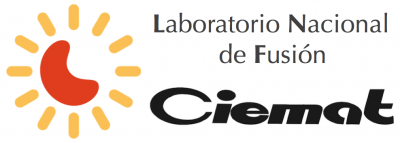Laboratorio Nacional de Fusión
The National Fusion Laboratory is part of CIEMAT.

The Laboratory is dedicated to the development of fusion by magnetic confinement as a future energy generation option. Research is mainly centered on the Flexible Heliac TJ-II, and on materials studies.
History
In 1975, a research group is created at the JEN (later to become CIEMAT) to study the subject of fusion. In 1983, the small tokamak TJ-I is taken into operation, followed by the torsatron TJ-IU in 1994, and the flexible heliac TJ-II in 1999.
Organization
Organization and personnel
Projects and research
Educational and training activities
The LNF is strongly committed with the education and training of new researchers in the field of magnetic fusion science and technology. It keeps a close collaboration on post-graduate teaching activities with Universities Carlos III, Complutense and Politécnica de Madrid. CIEMAT participates with these two latter institutions in the Campus de Excelencia Moncloa. In the last ten years, in average, three to four PhD thesis/year and four Master Thesis/year are being successfully finished in the LNF facilities.
The LNF is a major Spanish partner of the "European Master of Science in Nuclear Fusion and Engineering Physics (Fusion-EP)", under the auspices of the Erasmus Mundus. In this Master course, international students have six month-stays at LNF and receive lectures given by its staff, among others. LNF is also actively participating in a new Erasmus Mundus programme-related initiative, the Fusion-Doctoral College recently established to host PhD students and supervise their thesis. In both programmes, LNF participates in close collaboration with several national (Complutense and Carlos III, Madrid) and international universities and research institutions (Ghent Univ., Lorraine Univ., Stuttgart Univ., [www.unipd.it/en/ Padova Univ.], Instituto Superior Tecnico (Lisbon), IRFM-CEA, IPP-Garching and IPP-Greifswald).
Computer resources
Due to the large computational needs of the Laboratory, it makes use of both internal and external resources through collaborations:
- The CIEMAT computing centre, with the following computers:
- JEN50 (SGI Origin system, already phased out)
- Lince (HPC cluster)
- Fenix (SGI Altix system w/ Itanium processors, currently being phased out)
- Euler (Dell HPC cluster, 1152 Xeon cores, 13.8 Tflops)
- The Barcelona Supercomputing Centre
- The Spanish Supercomputing Network
- LUSITANIA
- BIFI (at the University of Zaragoza)
- EGEE (Enabling Grids for E-SciencE, a European computational grid)
- Ibercivis (Spanish computational grid)
Collaborations
The Laboratory participates in many international projects and collaborates with other institutions, such as:
Events
The Laboratory has organised many events, among which:
- The 21st Symposium on Fusion Technology (SOFT, 2000)
- The 9th EU-US Transport Task Force Meeting (TTF, 2002)
- The 32nd European Physical Society Conference on Plasma Physics (EPS, 2005)
- The 15th International Stellarator Workshop (ISW, 2005)
- The 12th European Fusion Theory Conference (EFTC, 2008)
- The 18th Conference on Plasma Surface Interactions (PSI, 2008)
- The 3rd EFDA Transport Topical Group meeting and 15th EU-US Transport Task Force Meeting (TTG-TTF, 2010)
- The 12th ITPA Energetic Particle Physics TG Meeting (2014)